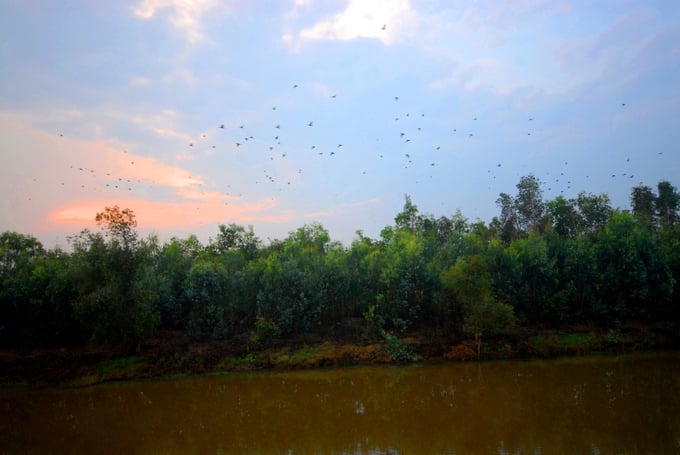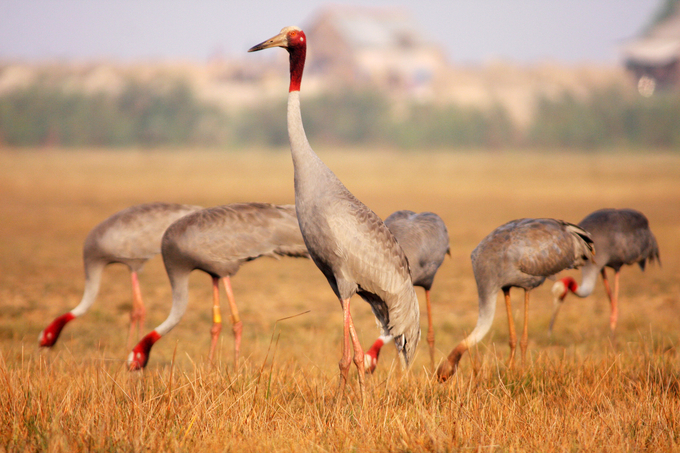November 19, 2025 | 18:11 GMT +7
November 19, 2025 | 18:11 GMT +7
Hotline: 0913.378.918
November 19, 2025 | 18:11 GMT +7
Hotline: 0913.378.918
Tram Chim National Park, located in Tam Nong District, Dong Thap Province, was once home to over 1,000 Sarus cranes, a rare bird species listed in the Redlist. However, due to various factors, the number of cranes returning to Tram Chim National Park has steadily decreased over the years. As of May 2022, statistics show that the sarus crane population in Vietnam and Cambodia has dwindled to fewer than 200 individuals, facing the risk of extinction in the near future.

Tram Chim National Park, located in Tam Nong District, Dong Thap Province, was once home to over 1,000 Sarus cranes, a rare bird species listed in the international Redlist. Photo: Le Hoang Vu.
In response to this alarming situation, the People’s Committee of Dong Thap Province approved a conservation and development plan for the sarus crane at Tram Chim National Park for the 2022-2032 period in November 2023. The project aims to restore the crane population by breeding and releasing them into the wild, with a goal of releasing 100 individuals over 10 years and ensuring at least 50 survive.
To realize this plan, Dong Thap Province has implemented a range of coordinated measures, including importing cranes from Thailand, researching breeding techniques, reintroducing the cranes, and, most importantly, restoring their habitat. The core areas of Tram Chim National Park are being rehabilitated by regulating water levels to simulate the natural flood-and-dry cycles of the Dong Thap Muoi wetland ecosystem.

Dr. Tran Triet, Director of the Southeast Asian Sarus Crane Conservation Program, emphasized: "A clean environment is the key to the cranes' return.". Photo: Le Hoang Vu.
Dr. Tran Triet, Director of the Southeast Asian Sarus Crane Conservation Program, emphasized that a clean environment is essential for the cranes’ return. The Sarus crane migrates seasonally, spending the rainy season in Cambodia and the dry season in the Mekong Delta. To encourage the cranes to stay year-round, the habitat must be suitable throughout their breeding season, including clean rice fields free from harmful chemicals and a nature-friendly ecosystem.
Efforts to regulate water levels in Tram Chim National Park during 2023 have yielded positive outcomes. The ecosystem has been rejuvenated, with noticeable increases in aquatic species and bird populations. Most notably, at the beginning of 2024, four Sarus cranes returned to Tram Chim National Park, offering a hopeful sign for habitat restoration.
Despite high expectations, the journey to bring the cranes back is challenging. Dong Thap's leadership has set ambitious goals, confident they can be achieved if the core habitat of Tram Chim National Park is properly restored. Alongside ecological restoration, the project integrates sustainable ecological agriculture models, ensuring local livelihoods while improving the environment. These models encourage farmers to transition from traditional farming to eco-friendly rice cultivation.
Master Nguyen Hoai Bao, a lecturer at the University of Natural Sciences, asserted: “We must transform Dong Thap into a land of harmony.” This requires a long-term commitment that could span decades or even centuries. Such efforts not only save the Sarus crane from extinction but also enhance environmental quality and improve living standards across the region.

The sarus crane conservation project not only aims to protect this rare bird species but also serves as a driving force for sustainable development at Tram Chim National Park. Photo: Le Hoang Vu.
The sarus crane conservation plan goes beyond protecting a rare bird species. It also serves as a catalyst for sustainable development at Tram Chim National Park. Combining ecological agriculture with environmental tourism is a strategic step to transform the park into a symbol of balance between nature conservation and economic development.
Reestablishing the natural environment, restoring the Dong Thap Muoi ecosystem, and ensuring sustainable livelihoods for local residents are crucial for achieving the ambitious goal of bringing the sarus crane back to Tram Chim National Park year-round. This effort involves not only rehabilitating the wetland's ecological integrity but also integrating sustainable agricultural practices that benefit both the environment and the local community.
By transitioning to eco-friendly rice farming and minimizing chemical use, Đồng Tháp Province is creating a harmonious balance between conservation and development. The return of the Sarus crane symbolizes the success of these initiatives, showcasing how dedicated restoration efforts can protect biodiversity while improving regional quality of life. Tràm Chim stands poised to become a model for blending nature conservation with sustainable economic growth, ensuring its role as a haven for wildlife and a source of pride for future generations.
Translated by Kieu Chi

(VAN) Viet Nam’s entry into the ACF Alliance expands opportunities for agricultural innovation, knowledge exchange, and deeper international cooperation.

(VAN) Vietnam remains committed to sustainable development, maintaining a harmonious balance among economic growth, environmental protection, and climate-change response.

(VAN) Deputy Prime Minister Tran Hong Ha convened a meeting with the MAE and relevant agencies to discuss the draft decree on national multidimensional poverty standards for the 2026 - 2030 period.

(VAN) The year 2025 marks the 10th anniversary since more than 190 countries adopted the Paris Agreement on climate change, paving the way for strengthened global action.

(VAN) The PepsiCo Foundation funded the project ‘New Harvest: Sustainable Agriculture Initiative’, focusing on regenerative agriculture and climate change.

(VAN) Dr. Nguyen Viet Hung, ILRI's Regional Director for Asia, emphasized the One Health approach in ensuring food safety and reducing antimicrobial resistance risks in livestock.

(VAN) The youth-driven initiative ‘Innovate for water, act for the future’ seeks practical, scalable solutions to Vietnam’s water challenges.